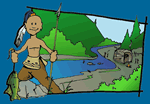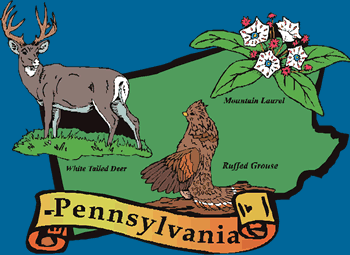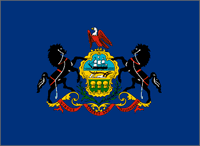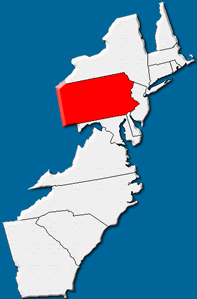


Geography and Landforms:
Pennsylvania is one of the Mid-Atlantic states. It is known as the Keystone State because it is geographically in the center of the "arch" formed by the original 13 states. Six are located to the north and six to the south. Pennsylvania's width is 312 miles. The distance between its northern and southern boundaries is 158 miles. It is America's 33rd largest state.
|
 History:
In 1643, the Governor of New Sweden, Johan Printz, established a capital for his colony near present-day Philadelphia and called it Tinicum Island. It was the first permanent settlement in the Pennsylvania region.
|
 Economy:
During the 19th and early 20th centuries, Pennsylvania was the nation's leading producer of steel. This was due to the state's rich deposits of bituminous (soft) coal and iron ore - two components that are fundamental to the steel industry. A thriving anthracite (hard) coal mining industry in Pennsylvania made the state a leader in railroading during this era. But such industries began to decline dramatically in Pennsylvania during the later half of the 20th century.
|
 First Inhabitants:
Native Americans lived in the area that became Pennsylvania hundreds of years before European settlers entered the region. The two primary groups were the Algonkian and Iroquois. Algonkian tribes included the Delaware, Nanticoke, and Shawnee. The Susquehannocks were an Iroquoian tribe that lived along the Susquehanna River.
|
Books Related To PennsylvaniaThe Year My Parents Ruined My Life - Martha Freeman An American Plague - Jim Murphy Chase - Jessie Haas Dead End in Norvelt - Jack Gantos The Hard Times Jar - Ethel Footman Smothers K is for Keystone: A Pennsylvania Alphabet - Kristen Kane Macaroni Boy - Katherine Ayres Woods Runner - Gary Paulsen |
Famous Citizens:
|
| Capital: | Harrisburg |
| Entered Union: | December 12, 1787 |
| Population: | 12,787,209 |
| Area | 46,055 |
| Bird | Ruffed Grouse |
| Flower | Mountain Laurel |
| Nickname: | Keystone State |
| Governor | Tom Wolf |
Places to Visit in Pennsylvania: (Click the links to learn more.)
|



